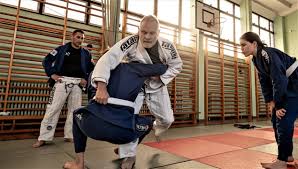Jiu-Jitsu was not suited to smaller players. Thus, he developed Brazilian Jiu-Jitsu. Since that time, his Gracie family has been keeping this dream going. To learn more about some of the methods, look at the strategies and methods taught by Roy Dean, BJJ, the world's best athlete.
However, if you're a beginner in BJJ, Here are some of the most effective techniques you can apply against larger opponents.
Best Training: Roy Dean Academy
Scissor Sweep
The entire idea behind this strategy is to help you get out of a sticky spot. If you notice your opponent over you, then all you have to do is grab the opponent's collar using one hand. On the other hand, you'll grasp the sleeves of your opponent's left hand.
You will now need to kick your opponent's left knee to simultaneously create a loss of balance; you must flip your opponent to the left. This is a simple technique to master with minimal effort. It will allow you to take control of the game even when your opponent is bigger than you.
Cross Collar Choke
It is Helio's most-loved move. You'll be strangling your opponent, and be careful not to injure. Take the collar of your opponent's with both hands so that your hands are crossed over one another.
Then, you'll make sure to pull your opponent's neck closer to you as possible. It is necessary to apply all of your body weight to press your opponent's neck.
Straight Arm Drill
The only thing you have to do is place one knee on your opponent's neck. The other knee is placed over the belly of your opponent. Then, you must keep your opponent in one hand using all your strength. This could be a transition to an armbar.
One of the most important aspects of this maneuver is that if you are pushed to the limit and executed correctly, you'll be able to perform an armbar the opponent has picked you up.
Toronto
You also called it "bullfighter's pass, This maneuver will allow you to take complete control of the fight, so you can throw a few punches or choose the submission.
If your rival is lying on the floor, you hold both legs with your ankles. Your opponent may try to punch you in the back, but when it occurs, you release one leg and throw your body over your opponent.
If you fall, you'll be required to slide your arm behind your opponent's neck. If you've done it right, you'll have one hand securely gripped your opponent's ankle and another in front of the neck.
Rear-Naked Choke
This is one of the most commonly used chokeholds that anyone could master. It would be best to slide the dominant arm beneath your opponent's chin when you're behind them.
It is necessary to bring your elbow in line with the opponent's chin. Then, you grab your other hand and hold it with as much force as possible. It is essential to ensure that you do not pull against your opponent's chin but instead move your hand downwards, putting pressure on the neck.
BJJ is very similar to traditional Jui-Jitsu, and learning the fundamentals isn't as hard as you imagine. The moves mentioned above are great options for those who are just beginning. Even if you have just started your resolution in the new year to be fitter through this thrilling fighting sport, the above techniques are still a great way to begin practicing.

Comments
Post a Comment